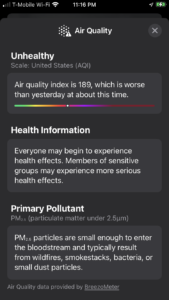Wildfire smoke consists of particulates in the air that are a principle health threat from short-term and longer-term exposure. The smoke has a complex mixture of pollutants that can lead to a variety of health effects ranging from minor eye and respiratory tract irritation to more serious conditions such as worsening an asthma condition and heart failure that could result in premature death.
The fine particles within the wildfire smoke are respiratory irritants, and exposure to high concentrations can cause persistent coughing, phlegm, wheezing and difficulty breathing. Therefore, it’s imperative to monitor the Air Quality Index, AQI. The AQI is typically available on a mobile phone’s weather app or you can visit www.AirNow.gov. The AQI will provide your locations current air quality and some basic health information. Here’s a screen shot of the AQI during the influence of wildfire smoke.
 Here’s a screenshot of the AQI influenced by wildfire smoke that has blown into the area. Wildfire smoke can effect an area hundreds of miles away from the existing fire depending upon wind conditions. Wind typically diffuses the smoke; however, during that diffusing process your area may be affected.
Here’s a screenshot of the AQI influenced by wildfire smoke that has blown into the area. Wildfire smoke can effect an area hundreds of miles away from the existing fire depending upon wind conditions. Wind typically diffuses the smoke; however, during that diffusing process your area may be affected.
In this case the AQI is 189. In comparison a “Good” is between 0 and 50, “Moderate” 51 and 100, “Unhealthy For Sensitive Groups” 101-150, “Unhealthy” 151-200, “Very Unhealthy” 201-300 and anything above 300 is “Hazardous”.
The inhalable particle size of wildfire smoke is about 2.5 microns. In comparison, a single hair from your head is about 70 microns and smaller. That’s roughly 30 times larger than the particles in wildfire smoke.
 The adjacent screenshot are more details of an “Unhealthy” AQI. Specifically, you can get some general health information and some basic information regarding the pollutant. So, what do you do when you encounter smoke filled air or a high AQI? You can follow the health guidance from the AQI, stay indoors if need be and preferably use a filtration system such as a hepa filter. A hepa filter is capable of filtering particles as small as 0.3 microns.
The adjacent screenshot are more details of an “Unhealthy” AQI. Specifically, you can get some general health information and some basic information regarding the pollutant. So, what do you do when you encounter smoke filled air or a high AQI? You can follow the health guidance from the AQI, stay indoors if need be and preferably use a filtration system such as a hepa filter. A hepa filter is capable of filtering particles as small as 0.3 microns.
The main thing is to get into the habit of monitoring the AQI and take the precautionary measures to promote a safe and healthy lifestyle.

